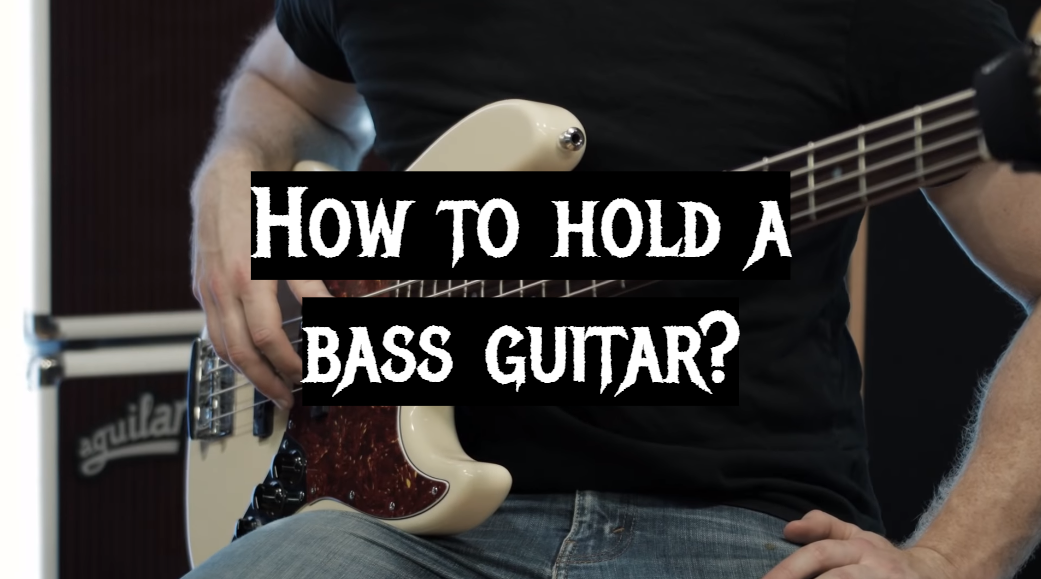You’ll find a lot of various ways to hold a bass guitar whether you observe other bass players live or on TV. Although some can seem to be cooler than others, performing with a good hand position may be daunting as the instrument scrapes against the ankles. That is why you need to learn the basics to prevent any injuries or inconveniences when playing this instrument.
Table of Contents
Prepare before playing the bass guitar: how to adjust the strap
When it’s time to put the bass on for the first time, take a seat. It’s also quicker to adjust the strap this way. The strings of the guitar can cross at a moderate upward angle between the beltline and belly button in the perfect case (up on the neck end). This position gives you the best coverage for your right and left hands, and it fits great if you’re standing or seated. Often, the strings should be faced outward.
Strapping on the bass seems as normal as riding a bicycle or walking after a while, but to get started, you’ll need to obey some simple directions. If you’re having trouble with your left hand when practicing, consider raising the bass’s height. If you’re having trouble with your right hand, consider dropping the bass.
Follow these measures to reach the perfect compromise position with both your left and right hands:
- Connect the thick end of the strap to the strap pin (the small metal knob) on the bass’s body at the neck end;
- Connect the thin end of the strap to the bass’s bottom strap pin (also known as the end pin);
- Pull the strap around your head and right shoulder, placing your right arm through as well, and hold your instrument solidly by the body or neck with your left hand;
- Enable the bass strap to land on your left shoulder and move over your back until it meets with the bass’s bottom strap pin just under the right side of the rib cage;
- Adjust the thickness of your strap until the strings are between the belly button and belt buckle, and fine-tune it from there;
- A strap is recommended for a more relaxed playing position. A broad strap, around 2-3 inches wide, is ideal for uniformly spreading the weight of the bass. Make sure the strap is at a comfortable length. The bass’s whole weight can be supported by the shoulder strap;
- The bass should be tilted slightly upwards (as seen in the picture below) to allow the left arm to travel freely when playing;
- If you choose to sit or stand when performing, make sure your bass is in the same position (strap length and angle) such that your playing is unaffected. Keep the guitar next to your body so you can easily hit any of its sections while playing.
Consider the angle and height of your bass guitar
Your playing is highly affected by the position and level at which you hold your bass. It governs the hand location, fretboard entry, endurance, and exhaustion, as well as causing or preventing typical musician injuries.
Experiment on how you hold the bass. Then, using your strap, change the height of your bass such that both of your arms hang in a comfortable position.
The body of the instrument would most likely land between the chest and hips of most citizens. The bass’s headstock would also be below shoulder and eye level.
If you’re a novice, most experts advise against going too short. While it seems to be cooler, your knees will kick it down and your body will suffer as a result. People would eventually find it’s awesome that you can play bass so well.
Often, whether you’re seated or standing, aim to move the bass so that it’s in a similar position. It would make you compete as much if you learn whether you sit while training and stand while performing. Learning how to play bass correctly needs a lot of consistency.
What is a horizontal bass syndrome (HBS)?
Most bass players make the error of turning their bass too far to the left. When you do so, the notes we use the most – the low ones – become more difficult to hit. That means you’ll have to stick out your fretting hand for the majority of the period you’re playing. On lengthy gigs and rehearsal hours, this is unnecessarily stressful.
It also allows it to be more challenging to hit the lower strings. Your ability to enter notes with your finger becomes ever more restricted.
It would be difficult to position the thumb correctly in a future lecture, as you will see.
Your wrists are forced to curve more quickly while your bass is horizontal. This is one of the many causes that contribute to hand injuries such as Carpal Tunnel Syndrome.
Know your positioning practices from guitar players with caution. They play shorter instruments and expend more time in various sections of the fretboard than most bass players do, depending on the style.
How should you slant a bass guitar?
HBS can be avoided by angling or slanting the bass. Both of the above issues are solved by angling the bass. Your wrists will both straighten. It draws both arms tighter to the neck, helping them to relax further. Your fingers have easier access to the strings as well as the whole fretboard set. Your thumb would be in a safer position on the back of your neck.
How to place the hands when playing the bass guitar:
The right hand
To play the notes on the bass, you may either use the right hand’s fingers to play the strings or a pick (a triangle-shaped piece of plastic kept in the right hand) to hit the strings.
The strings are usually played with the right hand’s fingers. At least, most bass players prefer such a position. A pick is usually selected by certain rock bass players because it helps to produce a crisper tone.
The left hand
The tips of your fingers should be positioned only below the frets (but not on top of them). The thumb of your left hand should be located behind the neck of the bass, roughly opposing your index and middle fingers, for added protection.
Two major positions to hold a bass guitar:
1) How to hold a bass guitar in a standing position:
Check to see that the strap is tightly fastened to the strap pins. Even, make sure the strap is straight from one end to the other, not twisted;
Allow your guitar to dangle from your shoulder loosely. Keep your left hand next to your neck while not clutching it. Some basses have a neck that is noticeably heavier than others, whereas some are fully balanced. You must become accustomed to the sensation of your bass, regardless of the form.
Placing hands on the instrument is a wise decision. Without trying to hold the bass, the left hand should be able to roam the neck from top to bottom. Your right hand ought to be able to easily cover all of the strings.
This position will be good for live performances.
2) How to hold a bass guitar in a sitting position
You may need to sit down and play during those boring hours of rehearsal. Use a large chair with no armrests or a stool. As a result, whether you’re standing or seated, the bass would be in a similar position. In addition, your legs should be at least parallel to the floor; if necessary, sit so that your thighs are higher than your knees.
Hold the strap on until you’ve sat back. When the bass hits the thighs, the strap can sag somewhat, but it should still hold the bass in position. The left hand is free to roam around the neck without worrying about keeping the bass in position, while your right hand will easily reach all of the strings.
Make it a priority to play while standing for half of the practice sessions. You have been forewarned.
You’ll want to sit in a chair that doesn’t have arms that get in the way of your guitar.
Though sitting is more comfortable but it has a number of drawbacks. When you sit, the bass is forced into various positions than when you stand. Keep in mind that accuracy accelerates learning.
Since the leg is higher as you sit, your bass is pushed higher or on the left. You’ll still most definitely hold your bass horizontally, adding many of the HBS issues listed above.
That is why most experts recommend having a stool or a higher chair with a perch on the edge. For example, you may buy one of Balans chairs.
How to play bass guitar with your fingers?
Your right hand is supported by leaning your thumb on the bass pickup, as seen in the shot. Two pickups are used on the majority of current bass guitars. Which is nearest to the fretboard, and the other is closer to the bridge. Since the string friction on the front pickup is not as “hard” as on the back pickup, it can be simpler to put your thumb on it in the early stages of playing. The note would sound fuller and stronger, and playing the strings using the right hand’s fingers will be simpler.
You can also try playing with the thumb on the back pickup, which produces a smoother sound with a more aggressive beat and “bite”.
The rest stroke is used for playing notes with fingers. The rest stroke includes the finger playing one string before coming to rest on the next one.
In an upward motion, play the third string (an outward motion). On the fourth string, fall to a stop.
Alternate between the index and middle fingers, ensuring that one of them is still lying on a string and the other is playing one.
Still use this contrasting fingerstyle when switching between notes and strings because it allows you more choices.
How to play bass guitar with a pick?
Picks are usually constructed of plastic and are available in a number of shapes and thicknesses. Thin picks appear to create a less specific pitch, so most bass players choose a medium/thick gauge pick.
To play the string, use the pick’s tip. Between the thumb and index finger, the pick is kept. This picking grip is used by a number of bass players.
When using the pick, shift the hand from the wrist to the fingers (do not stir your arm). Place your right hand’s palm on the guitar body for protection, or rest the other right hand’s fingers on the body. Use a downward pick move.
How to avoid finger pain when holding and playing the bass guitar?
If you are a fairly new bass guitar player, you may face the problem of finger pain after long sessions when you learn to play this instrument. Know that if your fingers hurt, you’re either doing something incorrect or your bass isn’t set up properly.
Experts sometimes agree that if you’re having problems playing, it’s almost certainly a concern with your strategy or configuration. If you’re getting things well, you’ll only get used to it if your fingers are properly pushing down on the fretboard with no slants. Allow blisters to recover if they arise. That’s how you’ll grow good calluses that will help the operation run more smoothly. Within a few weeks, you will develop hard calluses.
How do famous bass players hold their guitars?
- Jaco Pastorius’ bass is well-angled, with the body of the bass at around waist height;
- Jack Bruce’s bass is a little smaller, but he holds a decent tilt;
- James Jamerson is seen here seated on a stool with his knee supported;
- Mike Porcaro sits with his head level and his back straight;
- Geddy Lee’s bass position is horizontal and low;
Final thoughts
Be careful when choosing a holding position for your bass guitar. Because it will be quite difficult to learn the new method after you’ve got used to the position of your hands, fingers and your whole body. Make sure to test a few available positions before finding the one that suits your style of playing the most.






Leave a Reply